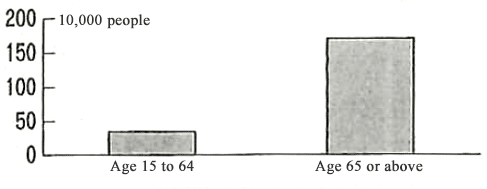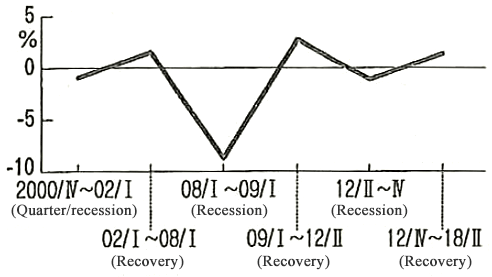Prime Minister Shinzo Abe was re-elected to a 3rd term as the president of the Liberal Democratic Party (LDP) of Japan in September, 2018. However, there was no particular positive sentiment as occurred when he was selected in the leadership elections up until now. When he was elected in 2012, the LDP was the opposition party, and there was a strong spirit of aiming to regain political power through the economic policies that would serve as the source of Abenomics. In 2015 when Abe was re-elected without a vote and Abenomics was well under way, an about-face was made and the three new arrows of Abenomics were launched.
Initially, Abenomics was a short-term policy that focused on escaping from deflation and boosting the economy with a focus on fiscal and monetary policies. In contrast to this, the three new arrows focus on growth policies and social policies including a gross domestic product (GDP) target of 600 trillion yen, improvements in the birth rate, and zero people quitting jobs to undertake nursing care. However, even though a cabinet reshuffle was conducted after the most recent leadership election, no notable economic vision has been released.
The government might claim that it is carrying out bold policies centered on labor. However, it is not clear how the policies currently being considered will lead to an escape from deflation and improvements in potential growth that have always been the stated goals of Abenomics.
It is likely the assessment of the economy has focused on supply and demand conditions in the labor market, and the judgment has been made that there is not much potential for deterioration in the economic sentiment from the perspective of the labor market because the population is expected to decrease in the future. Are there really no blind spots in this economic assessment?
♦ ♦ ♦
When considering the future domestic and overseas trends in the economy separately, there are few negative elements in domestic trends. Construction demand and tourism demand can be expected to continue to increase ahead of the Tokyo Olympics in 2020. In addition, as investments in rationalization and streamlining in response to a shortage of manpower continue, labor demand can be expected to remain tight. On the other hand, there is growing uncertainty regarding developments overseas. Perhaps the largest uncertainty is the trade friction being caused by the US. There is a high possibility that Japanese companies which are pursuing local production in China and that have incorporated China into their supply chain will be forced to rebuild their overseas investment strategies and supply chains.
In addition, trade negotiations will begin between Japan and the US in the future. In the worst case, there are concerns that Japan could be recognized as a currency manipulator or that tariffs could be increased like in the 1980s under Article 301 of the Trade Act. In any event, it is necessary to be prepared for these situations limiting Japanese exports over the short term and causing a burden of having to review foreign direct investment and the supply chain over the long term.
Current US trade policy will likely continue as long as Trump is president, regardless of the results of the mid-term elections in November. The volatility in the global stock markets since October can be viewed as a reaction in anticipation of long-term trade friction centered on the US.
One more cause for concern overseas is the possibility of the economic meltdown of emerging countries as a result of rising interest rates in the US. Amidst the circulation of U.S. dollars back into the US that had been pouring out around the world under the lower interest rates following the global financial crisis, there are fears that some emerging countries will be faced with a liquidity crisis and signs of such a crisis can already be seen in some countries.
What should be feared the most is the bankruptcy of emerging countries causing a crisis for creditors in developed countries, leading to a wide-ranging financial crisis. If China, which has become the world's second largest economy, has to focus on maintaining its own economy due to the trade war between the US and China, and a financial crisis occurs, it could take considerable time for the crisis to be resolved.
The results of the September Tankan survey acutely reflect these domestic and overseas trends. Although the employment conditions DI (Diffusion Index) indicates tightness in a continued strong labor market and capital expenditure plans continue to be robust, overall business sentiment has gradually declined since the end of last year. This gradual decline in business sentiment is seen to reflect the anxiety of Japanese companies towards these external negative factors.
♦ ♦ ♦
The Abe administration has adopted a defensive economic policy in an attempt to maintain the form of economic recovery that has continued in the past few years to the extent possible. Although there has been a focus on labor market reform recently, the reality is that even if frameworks for accepting more foreign workers were expanded and the employment period was extended to age 70, it seems that the numbers are just being made to match in order to maintain the current business model.
In particular, concerning the extension of the employment period until age 70, there are doubts as to whether action by the government is needed. According to the Labour Force Survey by the Ministry of Internal Affairs and Communications, the number of newly employed people increased by 2.04 million from 2013 immediately following the beginning of Abenomics to 2017. However, no more than 1/5 of this increase (0.34 million) was workers age 15 to 64, and the remaining 1.7 million were workers age 65 or over (see Figure 1). What this means is that companies had voluntarily employed the elderly before policies were devised by the government.

While this defensive policy by the government was probably underpinned by response to social security including pensions, what the government should do is secure funds by hiking the consumption tax rate as pledged in accordance with uniform reform of the tax and social security system.
Similarly, the government should not adopt policies that interfere with the revisions to job searching rules and new simultaneous recruiting rules that are being adopted by Keidanren. Although it costs money to move to new personnel systems, private sector companies will think of measures to acquire better human resources even if they have to cover such costs. What the government should do is support such reasonable and forward-looking efforts by companies.
As long as no sudden major negative events occur overseas, this is highly likely to be the longest period of economic recovery since WW2. Nonetheless, there is sure to be a recession at some point. In that event, there is much uncertainty about whether it will be possible to overcome external negative shocks with an economy with low growth potential like now.
Since the war, the longest economic recovery started in February 2002 and continued for 73 months, supported by the completion of the disposal of non-performing loans and growth in exports as a result of the expansion of the global economy. However, it is not as if the competitiveness of Japanese companies increased during this period. This was actually a period in which the productivity gap with China and South Korea was reduced.
The decline in the relative competitiveness of Japan became pronounced as a result of the contraction in world trade stemming from the financial crisis in 2008. Regardless of the fact that there were no major problems in the financial sector, the decline in GDP for Japan was the largest among developed countries.
Although the GDP increased by about 10% over the 6 years from 2002, most of this growth was lost during the recession following the global financial crisis (refer to Figure 2). China used this as an opportunity to outpace Japan and become the world's second largest economy.

On reflection, although the current economic recovery is close to the longest following WW2, the stance towards financial policy is almost the same as it was when Abenomics started, and there is almost no room for easing financial policy should an economic downturn start. If an overseas event were to cause a negative shock on the global economy, Japan is not in a position that would allow the adoption of autonomous measures, and it would have to rely on the economic stimulus measures of the US and China.
♦ ♦ ♦
According to New York University Professor Paul Romer, who won the Nobel Prize in economics in 2018, there is the potential for long-term improvements in the economic growth rate by shifting the distribution of economic resources to the knowledge economy. Although Prime Minister Abe indicated his enthusiasm towards this new knowledge-based economy in the opening of his policy speech made at an extraordinary session of the Diet in October, the subsequent concrete policies did not necessarily further pursue this way of thinking.
In fact, a stance that goes against conventional growth strategy, including responses to the sharing economy and labor market reform, can be seen in recent structural policy. The government should approach policy management with the awareness that if things go wrong with the policy of trying to maintain the current economic structure, it could place the longest economic recovery after WW2 back at square one.
* Translated by RIETI.
November 5, 2018 Nihon Keizai Shimbun


